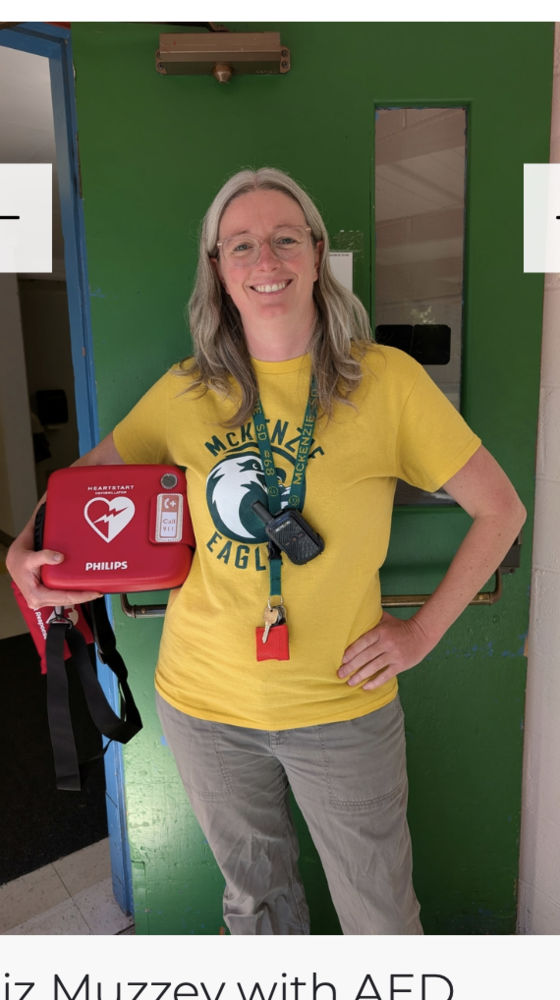Skip NavigationSkip to main content
Preparedness saves teacher’s life at McKenzie River Community School
School nurse’s quick action highlights the critical importance of emergency preparedness in schools
EUGENE, ORE., October 10, 2025 — It was a typical day at McKenzie River Community School until the unthinkable happened.
Liz Muzzey, the school’s health services coordinator, registered nurse and American Heart Association CPR instructor, was in her office helping a teacher with a routine request. The teacher left, but within seconds urgent cries for help from another staff member echoed through the hallway. Liz rushed out to find the teacher collapsed in the elementary entrance, wedged between the door and a garbage can, gasping and without a pulse.
Recognizing the signs of a cardiac arrest, Liz’s training kicked in immediately. Without hesitation, she directed the other staff member to call 911, moved the teacher to a safe location on the ground and began Hands-Only CPR.
Moments later, another teacher arrived, and Liz directed them to retrieve the automated external defibrillator (AED). The AED, newly installed thanks to Liz’s efforts, was quickly hooked up—no shock was advised. The presence of a trained responder and a working AED made all the difference. After about 90 seconds of CPR, the teacher resumed breathing on their own. Within another minute, they regained consciousness and began to get oriented, as first responders arrived.
The teacher’s first memory was Liz saying, “They're back!” Today, the teacher is back in the classroom, living proof of the importance of preparedness.
This dramatic rescue was not a matter of luck; it was the result of intentional planning and advocacy. When Liz joined the McKenzie School District, she discovered that the two existing AEDs were outdated, with dead batteries and used pads. Recognizing the risk, Liz launched a campaign to secure new AEDs for every building on campus.
But equipment alone isn’t enough. Liz also developed a cardiac emergency response plan and began assembling a team, organizing drills and training staff. She worked with HEARTSafe Eugene/Springfield to become the second school in Oregon with a HEARTSafe School certification.
After the real-life CPR emergency, the school partnered with the local fire to conduct four full-scale drills in one day. Staff saw firsthand what a cardiac emergency response entails, and the experience transformed their attitudes. “I went from just being Liz, the nurse, to someone they really listen to and respect,” Liz said.
Cardiac arrest can strike anyone, anywhere, at any time. Nine out of 10 cases of cardiac arrest are fatal, but CPR, especially if performed immediately, can double or triple the chance of survival.1 The teacher who collapsed had shown no warning signs and had just finished a normal conversation.
“There was nothing out of the ordinary,” Liz emphasized. “It just happened.” The outcome could have been very different if the teacher had been alone, or if the AED hadn’t been available. The presence of a trained responder and a working AED made all the difference.
“Anyone can call 911, start CPR and use an AED,” Liz said. “Hands-only CPR is effective, and AEDs are simple and safe to use.” She regularly teaches CPR and first aid and always encourages people to familiarize themselves with AEDs. “They’re intimidating to a lot of people, but it’s really simple. You just turn it on and follow the instructions,” she explained.
The American Heart Association, a relentless force changing the future of health for everyone everywhere, urges all schools to prioritize cardiac emergency preparedness. The Association is working to pass policy through the Oregon Legislature that would ensure all public schools have written cardiac emergency response plans for the school day and for after school sponsored activities. These plans would make sure AEDs are accessible and regularly checked, and that CPR training is required for appropriate staff.
As Liz’s experience shows, these steps are not difficult, but they require intentionality. That intentionality will save lives.
Additional Resources:
1 What is cardiac arrest? Why is it so deadly?
###
About the American Heart Association
The American Heart Association is a relentless force for a world of longer, healthier lives. Dedicated to ensuring equitable health in all communities, the organization has been a leading source of health information for more than one hundred years. Supported by more than 35 million volunteers globally, we fund groundbreaking research, advocate for the public’s health, and provide critical resources to save and improve lives affected by cardiovascular disease and stroke. By driving breakthroughs and implementing proven solutions in science, policy, and care, we work tirelessly to advance health and transform lives every day. Connect with us on heart.org/oregon, Facebook, X or by calling 1-800-AHA-USA1.
For Media Inquiries:
Jay Wintermeyer: jay.wintermeyer@heart.org
Public Inquiries:
1-800-AHA-USA1 (242-8721), heart.org and stroke.org
![]()
This link is provided for convenience only and is not an endorsement of either the linked-to entity or any product or service.

